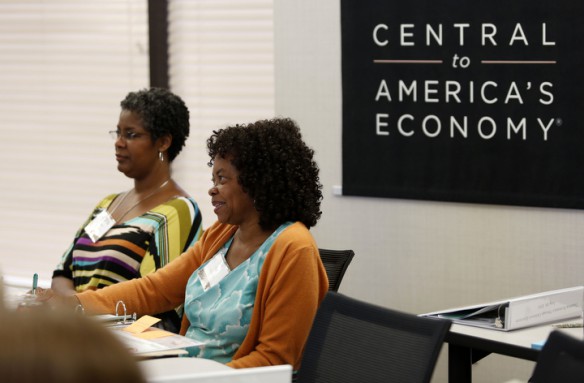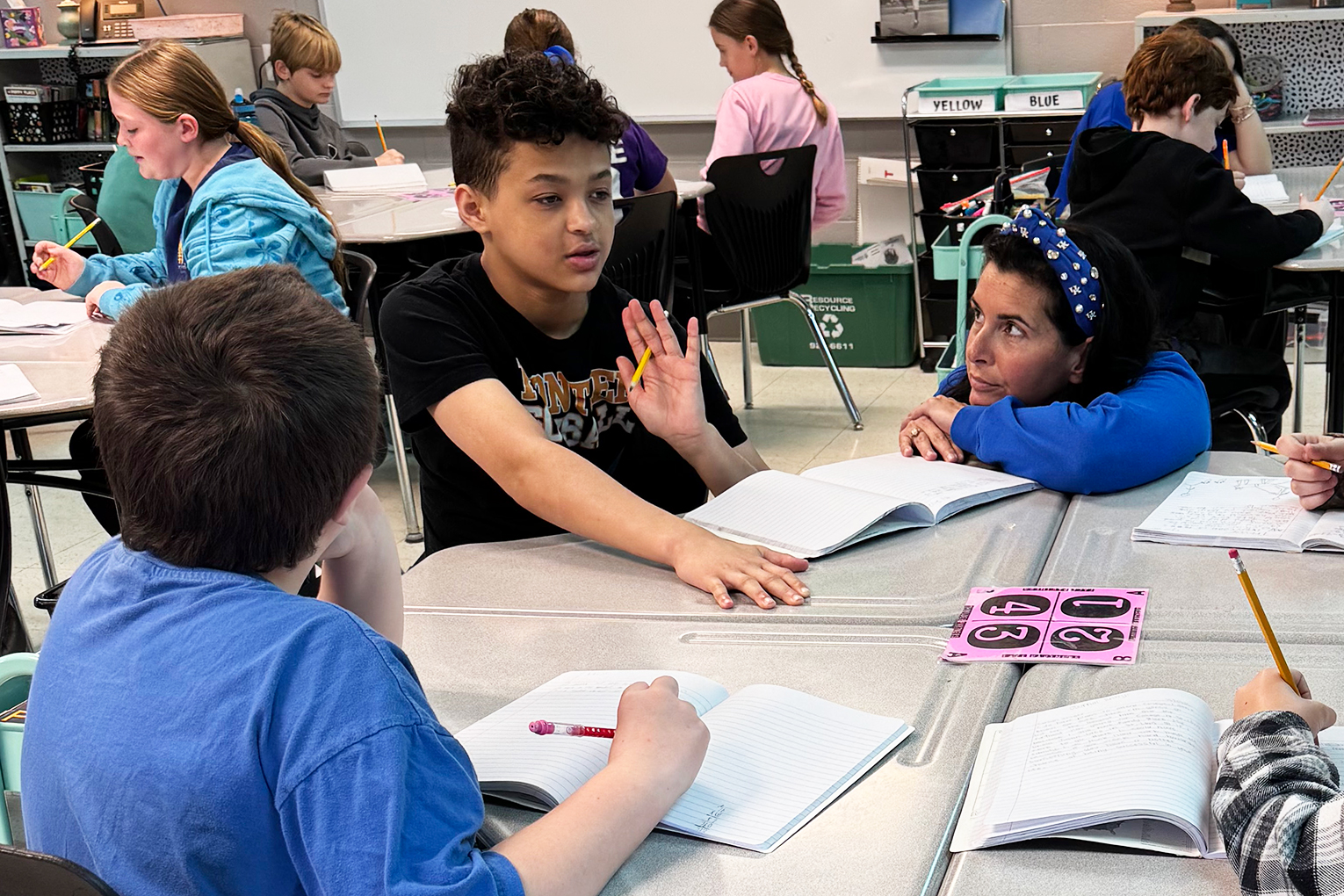
Brandeis Elementary School (Jefferson County) primary teachers Regina Puryear and Etta Ray listen to a story highlighting scarcity during the Teaching Economics through Children’s Literature Workshop. Photo by Amy Wallot, June 26, 2013
By Susan Riddell
susan.riddell@education.ky.gov
When asked what the biggest student benefit for children exposed to early financial literacy is, Erin Yetter was torn.
“That’s a tough one to answer because there are so many benefits,” said Yetter, an economic education specialist for the Louisville Branch of the Federal Reserve Bank of St. Louis.
“If we want students to be informed decision makers, then they need to learn economics,” Yetter said. “Just as you wouldn’t teach mathematics in one grade and then expect students to be college- or career-ready upon graduation from high school, we shouldn’t expect the same for economics. We need to teach these concepts and skills throughout the grades in order to ensure that students become adults who are informed decision makers.”
Yetter added that being an informed decision maker is one of the basic premises of economic literacy “which is imperative for any democratic society,” she said.
Yetter facilitated two professional learning opportunities recently in Louisville that demonstrated how educators can integrate financial literacy and economic lessons into primary and middle school curriculum.
“This is giving us a good sense of direction,” Etta Ray, a 2nd grade teacher at Brandeis Elementary School (Jefferson County), said of the event. “I’m really looking forward to using this in my classroom because it is important knowledge that has reading and mathematics skills tied together.”
Both Ray and fellow Brandeis Elementary teacher Regina Puryear said they were pleasantly surprise with the large dose of mathematics concepts in the financial literacy and economics curriculum that Yetter presented.
That integration of mathematics into her lessons was intentional, Yetter said, because it supports the Kentucky Core Academic Standards in mathematics and English/language arts.
“In an already very crowded curriculum, teachers are looking for ways to integrate the learning of one subject into the learning of another,” Yetter said. “At a very basic level, this is what Common Core aims to do. It says we should be teaching math and reading skills in every subject (not just in math and reading). So, this workshop showed teachers how to integrate economics with those subjects.”
Two of the lessons Yetter presented at the elementary school event featured the books So Few of Me and Bunny Money. She explained how each book connects to the standards, demonstrated what the lessons should look like with students, and offered suggestions for going a little deeper with the content for more advanced students.
For example, So Few of Me touches on choice, alternatives, opportunity cost and scarcity. With more advanced students, Yetter suggested conversations be developed regarding preferences. Discussions about schedules and how they are used in everyday life could also be developed to show the students how the lesson applies outside the classroom in their everyday lives. “Kids need to have these economic concepts, and unless we teach the concepts to them they won’t know about them,” Puryear said. “The sooner they get these concepts the better.”
Yetter added that because most of the Federal Reserve Bank’s lessons integrate mathematics, teachers can add to the content by introducing higher level mathematics skills, as well.
Integrating financial literacy and economics concepts into literature is appropriate for older students, too. For example, two of the Federal Reserve Bank’s middle school lessons use My Side of the Mountain and Little House in the Big Woods.
With My Side of the Mountain, students discuss human capital. Students work in groups to create a four-fold chart to help define and understand the meaning of investment in human capital. Students use a Know-Want-Learn-How chart to create a plan for investing in their human capital.
In the Little House in the Big Woods lesson, students learn about production functions, inputs, outputs, intermediate goods and productive resources such as human resources, capital resources and natural resources.
“It’s been interesting to see how everything ties together,” Puryear said. “These lessons are ideal for students to learn these important concepts. I’m looking forward to sharing them at school and in our (professional learning communities).”
Kentucky Department of Education literacy consultant MK Overstreet echoed former U.S. Federal Reserve Chairman Alan Greenspan’s comments in a 2001 speech that financial literacy is especially important in the early stages of a child’s education, and that professional learning opportunities assist teachers in providing this critical instruction.
“(Greenspan) said in a speech to the Community Affairs Research Conference of the Federal Reserve System that basic financial education in the early education years builds a strong foundation that can help students avoid making poor and sometimes insurmountable financial decisions,” Overstreet said.
“Teachers who integrate financial literacy into their curriculum are taking a positive step toward equipping students for some of the most complicated matters they’ll inevitably have to face as adults.”
MORE INFO …
Erin Yetter, erin.a.yetter@stls.frb.org, (502) 568-9257








Leave A Comment